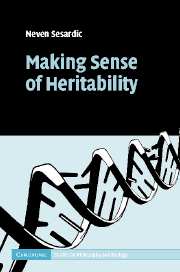Book contents
- Frontmatter
- Contents
- List of figures
- Acknowledgments
- Introduction
- 1 The nature–nurture debate: a premature burial?
- 2 A tangle of interactions: separating genetic and environmental influences
- 3 Lost in correlations? Direct and indirect genetic causes
- 4 From individuals to groups: genetics and race
- 5 Genes and malleability
- 6 Science and sensitivity
- 7 Conclusion
- References
- Index
3 - Lost in correlations? Direct and indirect genetic causes
Published online by Cambridge University Press: 22 September 2009
- Frontmatter
- Contents
- List of figures
- Acknowledgments
- Introduction
- 1 The nature–nurture debate: a premature burial?
- 2 A tangle of interactions: separating genetic and environmental influences
- 3 Lost in correlations? Direct and indirect genetic causes
- 4 From individuals to groups: genetics and race
- 5 Genes and malleability
- 6 Science and sensitivity
- 7 Conclusion
- References
- Index
Summary
Unless you are willing simply to deny that causality is a meaningful concept then you will need some way of studying causal relationships when randomized experiments cannot be performed. Maintain your skepticism if you wish, but grant me the benefit of your doubt. A healthy skepticism while in a car dealership will keep you from buying a “lemon.” An unhealthy skepticism might prevent you from obtaining a reliable means of transport.
Bill ShipleyThe fact that organisms with genotype G1 may have phenotype P1 more often than organisms with genotype G2 is not necessarily a good indication that a G-difference is directly responsible for a P-difference. It may well be that (for whatever reason) G1 organisms simply find themselves more frequently in environment E1 than G2 organisms, and that it is E1 which causally leads to phenotype P1 (while E2 produces P2). This phenomenon is called “genotype–environment correlation.” It has been extensively discussed in the behavior genetics literature, but it has also been widely used in methodological criticisms of heritability.
The expression “genotype–environment correlation” usually refers to the situations where two separate sources of phenotypic variance (genetic and environmental) happen to be correlated. Sometimes, however, it is interpreted more broadly to cover also the cases where there is a correlation between a genetic and environmental characteristic, even when the genetic characteristic is not directly influencing the phenotype.
- Type
- Chapter
- Information
- Making Sense of Heritability , pp. 89 - 126Publisher: Cambridge University PressPrint publication year: 2005



